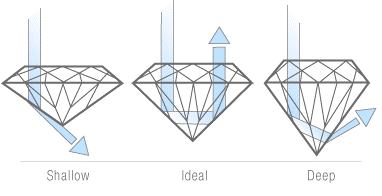A diamond’s cut is the most critical of the 4Cs because it’s what gives the diamond its brilliance, sparkle, and fire – the diamond’s three main attributes. When people talk about “brilliance,” they are referring to the amount of light a diamond reflects. “Fire” describes the way the light disperses and how the diamond shows off the different colors of the spectrum. “Sparkle” – also known as “scintillation” – defines how much the diamond shimmers when you move it around in the light. When light enters the diamond, it is refracted and bounces back out in a rainbow of colors.
The way a diamond is cut will have the biggest effect on how the stone catches and interacts with light. It is the ultimate expression of a craftsman’s skill in transforming a rough diamond into a breathtaking gem. If the diamond is too shallow and not cut right, some of the light will be lost out of the bottom. One that is cut too deeply will lose light out the side of its base. An Ideal Cut diamond will reflect most of the light through their table or top surface.
Proportion
An Ideal cut has a specific set of guidelines defining the proportions that give a diamond the highest level of fire and brilliance. It takes into account the relationship between the table size, crown angle, pavilion angle, girdle, crown depth and pavilion depth. It evaluates the following:
- the size of the table (flat surface) relative to the stone’s width at its widest point, called the girdle
- the angles of all facets relative to one another
- the depth of the crown vs. the pavilion and how well the facets at the crown (top) align with the pavilion (bottom)
The following diagram outlines a diamond’s basic proportions:
It’s important to note that the cut depends on the stone’s shape while it does not describe the shape. The most popular shape is the round brilliant diamond that is cut with 57 facets. When the culet is flattened into a facet, a round diamond will have 58 facets.
Other shapes are usually referred to as “fancy shapes,” and include princess, emerald, asscher, marquise, oval, radiant, pear, heart and cushion. Each diamond shape has its own set of guidelines that determine the quality level of its cut.
Symmetry
Grading reports also rate the overall symmetry of the diamond’s facets and how well facet edges align with each other, how corresponding facets from opposite sides of the diamond align with each other and the relationship between crown facets and pavilion facets.
Fluorescence
When exposed to ultraviolet light, a small percentage of diamonds fluoresce, or emit a blue or yellow light. Fluorescence is caused by trace elements, usually boron, that seep into the diamond when it is created. While fluorescence does not necessarily affect a diamond’s value, it is listed on a diamond grading report.















